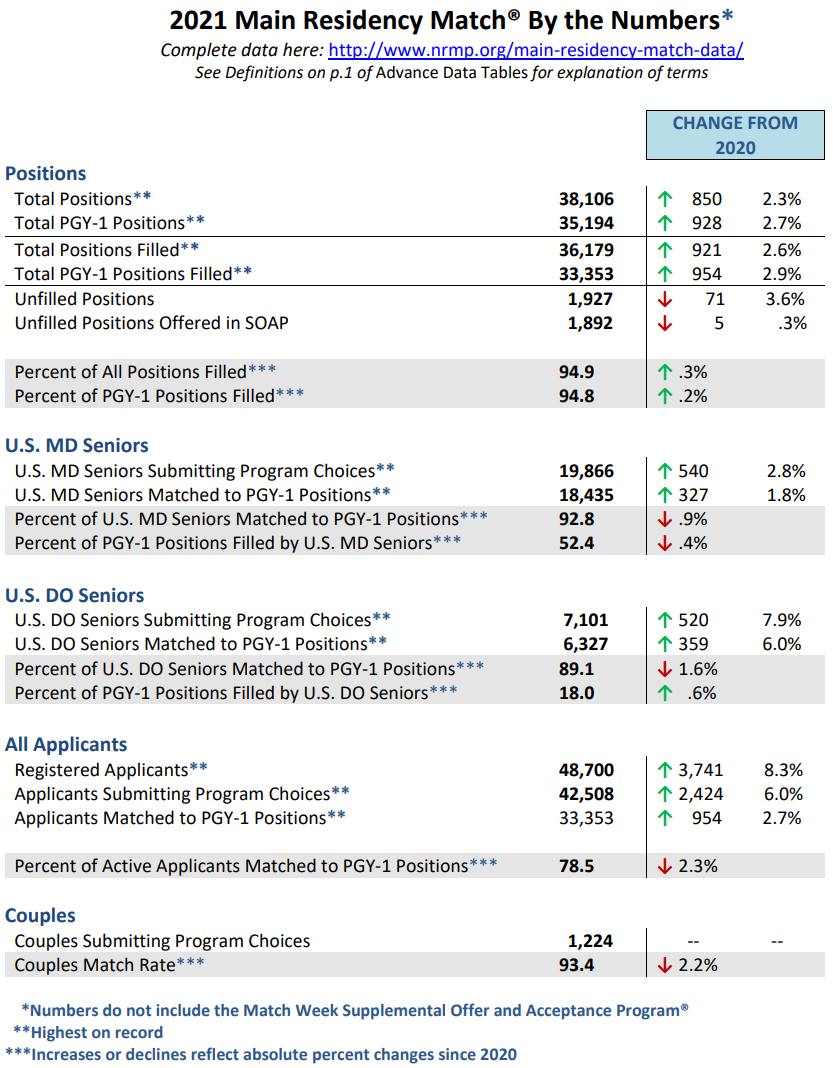Remembering the unmatched: A look at the 2021 NRMP Residency Match
💬 comments
On March 19, 2021, the NRMP released the results of the 2021 NRMP Residency Match, the process by which senior/fourth-year medical students learn where they will be going for their residency training following a months-long application and interview season. Love it or hate it, the Match is intended to maximize the number of program-applicant pairings using a computer algorithm in lieu of a traditional job market and hiring process. Let's take a look at this year's results:

Unfortunately, the match rate dropped across the board for all types of applicants. If we crunch the numbers, that's 1,431 unmatched US MD students and 774 unmatched US DO students - a total of 2,205 unmatched US medical students. The number of unmatched international medical graduates isn't mentioned in this preliminary data, but based on the All Applicants data, we can conservatively estimate there are at least a few thousand. Altogether, that's several thousand medical students, soon to be graduating as newly minted physicians, left with nothing in the way of job prospects and no pathway toward becoming a board-eligible/board-certified attending physician. This complete dearth of career prospects as an unmatched physician with no way to utilize their hard-earned MD or DO degree has, unfortunately, driven some unmatched physicians to suicide. While unmatched applicants are able to reapply next year, it's no secret that reapplicants are hugely stigmatized and often face an uphill battle in trying to match into their originally intended specialty, especially so for competitive specialties. Realistically, many, if not most reapplicants to residency are now only going to be competitive for less competitive fields such as internal medicine or family medicine. The alternative, quite literally, is unemployment and a complete squandering of the blood, sweat, and tears that go into four years of medical school and several thousand hours' worth of clinical training.

Meanwhile, the number of nurse practitioners is exploding. The 100%-online, 500-clinical-hour curriculum that is typical of today's nurse practitioner "programs" at for-profit institutions is simply incomparable to the caliber, length, and rigor of a medical school education. With NP diploma mills willing to accept virtually any warm body with a pulse and a wallet, and the number of NP graduates per year rivaling or exceeding the number of medical school graduates per year at this point, it's truly mind-boggling why hospitals and health systems are not tapping into the infinitely more qualified, several-thousand-strong labor pool of unmatched physicians. The vast majority of these folks would be ready to pick up their belongings, relocate at a moment's notice to secure gainful employment, and work for less than a midlevel, especially if the job provided a pathway to a residency position. The state of Missouri already allows medical school graduates who have not completed a residency to work in a limited, supervised capacity as assistant physicians. The Arizona legislature is currently considering the implementation of a similar framework in SB 1271. Just imagine what could be possible if an assistant physician pathway were to be standardized and implemented at a national level, the plight of the unmatched physician would be a thing of the past.
